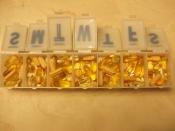2)
In the early 20th century the discovery of vitamins began. Today there is a chance that there are some vitamins that are still undiscovered. The definition of vitamin is: one of several substances necessary for animal nutrition, and occurring in minute quantities in natural foods; numerous types have been distinguished, and designated by the letters of the alphabet. Each and every living animal needs vitamins to grow and be healthy.
Since the human body can t produce vitamins naturally or normally produce the amounts needed, food provides the body with them. There are different vitamins found in different foods. These vitamins give vital nutrients to an animal.
In 1906, the British biochemist Sir. Frederick Hopkins demonstrated that foods contain accessory factors in addition to proteins, carbohydrates, fats, minerals and water. Then, in 1912, thee chemist Casimir Funk identified that the
(3)
antiberiberi substance in unpolished rice was an amine (a type of
Nitrogen-containing compound), so Funk proposed that it be named vitamine, from vital amine.
It was later discovered that different vitamins have different chemical properties. This discovery caused vitamine to be turned into vitamin.
In 1912 Hopkins and Funk made a hypothesis. The hypothesis stated the absence of some vitamins could cause diseases such as beriberi and scurvy. Later a letter was assigned to each vitamin. The letters which were assigned to vitamins in the early years of vitamin research categorize them according to their functions. As research progressed, the vitamins were given scientific names.
Foods that contain vitamins are very essential for good health and growth. Milk can be important because it is a source of vitamin D. Vitamin D is important because it is essential for bone growth.
(4)
Butter can be important because it is a source of Vitamin A. The pigments that are converted...


